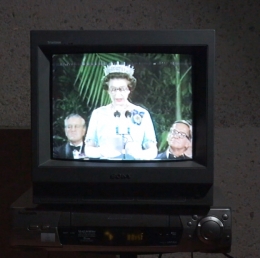UNSW Art & Design researchers will present an experimental history at the Know My Name Conference.
UNSW Art & Design’s Dr Diana Baker Smith and Dr Verónica Tello will present a video essay Opening Night (The Order of Arrangements, 2020) at the National Gallery of Australia’s (NGA) upcoming Know My Name Conference. The virtual conference, which runs from 10–13 November 2020, will bring together leading global thinkers on gender, feminism and the arts.
The researchers’ video uses the NGA’s opening night as its focal point and analyses the way the gallery put in place an ‘order of arrangements’ – what can be said about a collection and under what conditions it can be seen.
“Our starting point is the ritual of the opening night. We adopt an experimental approach to history, engaging with the NGA’s archives so we can ground the work in a specific Australian context, while also using fiction – redacting, erasing and including new information from the archives,” says Dr Baker Smith.
While not being about the NGA specifically, the work uses the gallery as a reference point. It speaks more broadly about how national art museums in a settler-colonial context produce and reproduce their origin stories.
“In many ways the video is specific to the Australian context, but there are probably universal aspects as to how national, or even state, museums order their collections in and beyond Australia, resonating with other settler-colonial contexts. We didn’t want to make the work about the NGA, but to use it as a base,” Dr Tello says.
The video is set in three spaces – the museum library, auditorium and the art store (where the art is stored). All three spaces are key for sustaining museum histories and narratives. Traversing these spaces, the video reconstructs the opening night of a national art museum (unidentified in the video), including VIP arrivals, speeches and the collection walkthrough.
“We especially focus on the opening night walkthrough because we want to show how a collection, especially a founding collection, embodies a much longer temporality than an exhibition. We wanted to explore the relationship between these temporalities, implicitly, in the video,” says Dr Tello.

The researchers have used archival material of the National Gallery’s opening night, including TV footage of Queen Elizabeth II.
The online conference is a companion to the exhibition Know My Name: Australian Women Artists 1900 to Now – the largest all-women presentation of art held in Australia to date – which opens to the public at the NGA on 14 November 2020 and runs to 14 July 2021. The National Gallery acknowledges that only 25 per cent of its Australian art collection is by women. As part of the Know My Name initiative, it has implemented new guiding principles to ensure gender parity in future programming, collection development and organisational structures.
“We want to make clear the conditions that make it possible, or not, for women to be visible in a settler-colonial museum,” says Dr Baker Smith. “Women tend to dominate as workers in a museum, for example. They care for the archives and artworks as librarians and art handlers – even if they are marginal in the collection. This comes out in our video essay as it traces how museum histories are reproduced.”
Dr Baker Smith and Dr Tello have been leading UNSW Sydney’s partnership with the Know My Name Conference, which also has the Australian National University (ANU) and University of Melbourne as university partners.
Know My Name is part of a global movement to increase representation of women identifying artists. It builds on the work of groups supporting gender equity cross the arts including Countess, Sheila Foundation and the #5WomenArtists campaign by the National Museum of Women in the Arts in Washington, DC.
Designed with accessibility in mind, the digital Know My Name Conference invites global audiences to join the conversation to create a more inclusive arts sector. Sessions will be live captioned, AUSLAN interpreted and audio described.

